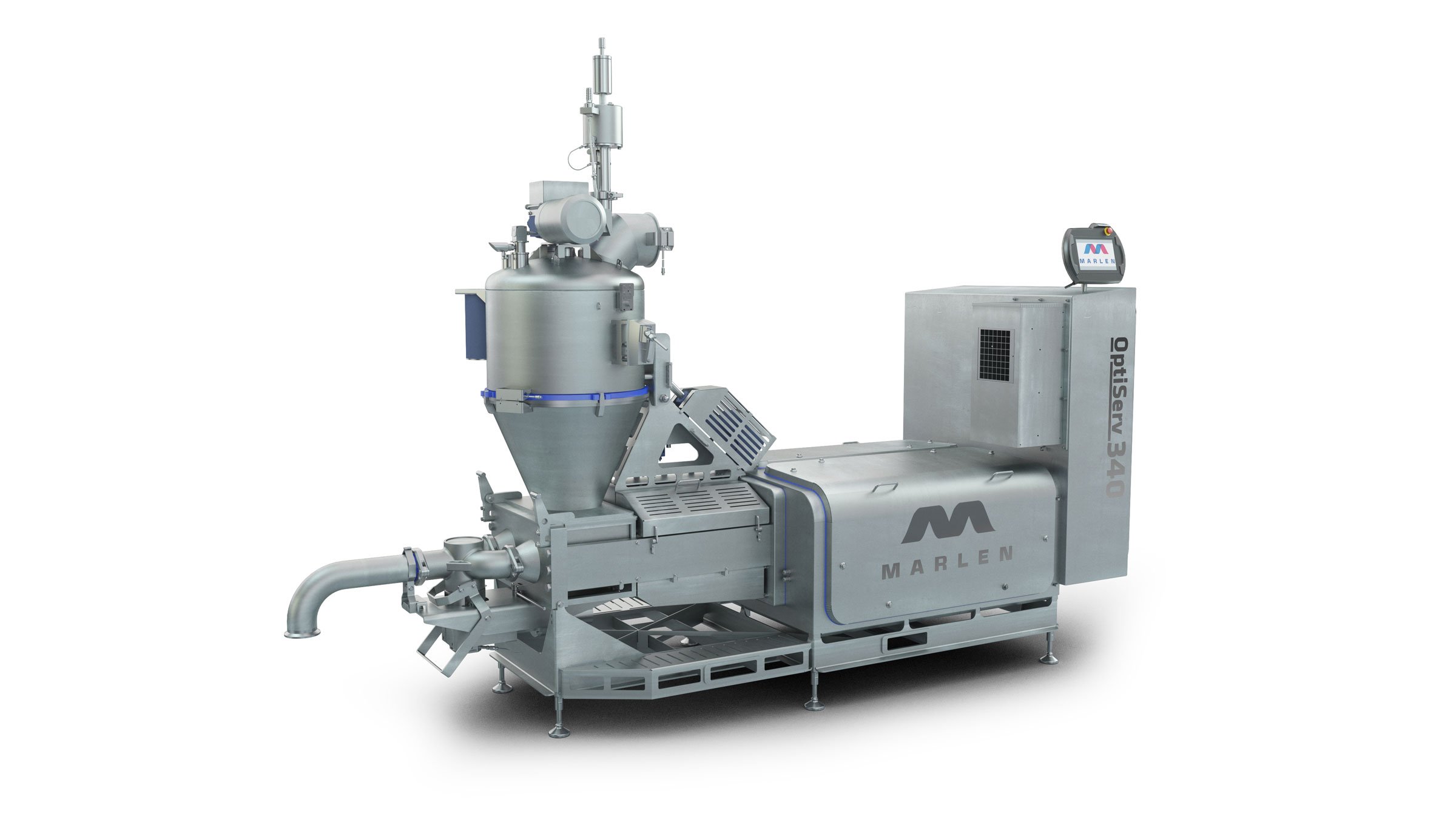Recommended For You
Challenge
- Improve portion precision, energy efficiency and sanitary design of food vacuum stuffing and pumping system.
Solutions
- Allen-Bradley CompactLogix 5370 controller
- Allen-Bradley Kinetix 5700 EtherNet/IP servo drives
- Allen-Bradley MP-Series food grade servo motors
- Allen-Bradley PowerFlex 525 AC drive
- Allen-Bradley PanelView Plus 7 stainless steel graphic terminal
Results
- Improves portion accuracy and product consistency
- Reduces energy usage by about 40%
- Features tool-free disassembly
- Enables machine teardown in about 2.5 minutes for sanitation
Designing equipment that performs consistently year after year in the harsh washdown environment of a meat or poultry processing plant is a challenge. So is keeping pace with evolving sanitary requirements, consumer trends, and new advances in technology.
Marlen, a premium manufacturer of highly engineered food processing equipment and systems, has addressed these challenges extraordinarily well with its longstanding and reliable line of Opti Series vacuum stuffing and pumping systems.
“We introduced our Opti pump series in the 1950s,” said Doug Wilson, director of engineering, Marlen. “It’s very typical to see our equipment running in plants more than 30 years after it was first installed.”
Recently, Marlen introduced the OptiServ 340, a model that promises more precise control, better energy efficiency – and hygienic design. The OptiServ 340 is designed for product throughput up to 34,000 pounds per hour.
From Hydraulics to Servos
OptiServ systems use vacuum pumps to portion and deposit whole muscle, sectioned, formed or emulsified meat or poultry into sausage casings, rollstock film packaging or downstream equipment.
Historically, Opti Series pumps and ancillary components were controlled by hydraulics. While these systems continue to perform well, Marlen opted for a different approach in their OptiServ 340 design to address an industry shift away from hydraulic systems.
“Our machines have always used food grade hydraulic oil,” Wilson said. “But manufacturers today simply do not want oils and other foreign materials anywhere near the product. This is one of the factors that drove us to design a servo system.”
“Also, servos can achieve a much higher degree of accuracy,” Wilson added.
Portioning precision is critical in all food packaging applications. To ensure product meets advertised packaged weight, manufacturers often err slightly on the heavy side when defining portion size.
“For manufacturers, even a one percent overage in portion weight can translate to thousands of dollars wasted,” Wilson said. “Our new system is designed to deliver precise portions every time.”
Tighter Tolerances. Better Accuracy.
The OptiServ 340 system features a two-piston servo design. Product enters the machine hopper where an auger drives it into the main vacuum chamber. Here, two cylindrical sleeves working opposite each other capture the product. Two piston pumps push the product through the sleeves and out the end of the machine. The front rotary valve shifts from left to right to distribute product from one piston to another, thereby maintaining continuous flow.
The machine runs on a Rockwell Automation control platform featuring an Allen-Bradley CompactLogix™ controller. Allen-Bradley MP-Series™ servo motors and Allen-Bradley Kinetix® 5700 EtherNet/IP™ servo drives control the piston pumps, sleeves and front rotary valve. An Allen-Bradley PowerFlex® 525 AC drive controls the auger. The system is integrated on EtherNet/IP and is monitored on an Allen-Bradley PanelView™ Plus 7 stainless steel graphic terminal.
“Servos have a much higher resolution than hydraulics, so you can maintain tighter tolerances and be more accurate with the product flow and portioning,” Wilson explained.
And because the servo-driven system also holds better vacuum, more entrapped air can be removed from the final product.
“The result is a great looking, consistent product,” Wilson said.
More Energy Efficiency
While servos are intrinsically more energy efficient than hydraulics, the OptiServ 340 system uses Kinetix 5700 regenerative bus supply capabilities to accelerate energy savings. The system monitors servo energy usage and regenerates excess energy back to the AC power source for other servos to use.
“Our customers are concerned about power management,” said Wilson. “And this system uses about 40% less energy than the hydraulic stuffers.”
Simpler to Maintain. Easier to Use.
The transition from hydraulics to servo control also results in a less complex system – with about one-third fewer parts.
“Hygienic design also improved system maintainability,” Wilson said. “Since the equipment handles raw products, it is cleaned at least once a day – and more often if there are changeovers.”
To ease sanitation, the machine features easy-to-clean sloped surfaces with no external hinges – and a patented no-leak electrical enclosure tested to withstand washdown procedures. In addition, the system features tool-free disassembly, which enables machine teardown in about 2.5 minutes.
The OptiServ 340 system also comes equipped with an innovative HMI based on icons – not words. Now standard on Marlen equipment, the HMI is designed to ease training and operation for a diverse – and often multilingual – workforce.
“Put simply, the new servo system is designed to address contemporary customer needs – and to drive a lower cost of ownership throughout the life of the equipment,” said Wilson.
Learn more about how Rockwell Automation helps improve machine builder performance.
Published November 2, 2020

